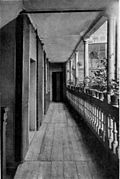Top Qs
Timeline
Chat
Perspective
The George Inn, Southwark
Grade I listed pub in London, England From Wikipedia, the free encyclopedia
Remove ads
The George Inn, or The George, is a public house established in the medieval period on Borough High Street in Southwark, London, owned and leased by the National Trust. It is located about 250 metres (820 ft) from the south side of the River Thames near London Bridge and is the only surviving galleried London coaching inn.[1]
Remove ads
Remove ads
History
The pub was formerly known as the George and Dragon, named after the legend of Saint George and the Dragon. It is possible that it was used for Elizabethan theatrical productions (Inn-yard theatre), as other galleried inns were.[citation needed]
A pub has existed on the site since medieval times. In 1677, it was rebuilt after a serious fire destroyed most of Southwark. The medieval pub was situated next door to The Tabard Inn where Chaucer set the beginning of The Canterbury Tales.[2]
Later, the Great Northern Railway used the George as a depot and pulled down two of its fronts to build warehousing. Now just the south face remains.[citation needed]
Charles Dickens visited The George, and referred to it in both Little Dorrit and Our Mutual Friend.[citation needed]
Remove ads
Description
The building is partly timber framed.[3] The ground floor is divided into a number of connected bars. The Parliament Bar used to be a waiting room for passengers on coaches. The Middle Bar was the Coffee Room, which was frequented by Charles Dickens. The bedrooms, now a restaurant, were upstairs in the galleried part of the building.[citation needed]
It is the only surviving galleried coaching inn in London. The White Hart was immediately to the north but was demolished in the nineteenth century. Immediately to the south was The Tabard (which was described in Chaucer's The Canterbury Tales); it too was demolished in the nineteenth century.
The building is listed Grade I on the National Heritage List for England, and is listed in the Campaign for Real Ale's National Inventory of Historic Pub Interiors.[4]
Remove ads
Gallery
- The sign depicts Saint George slaying a dragon.
- Secondary sign, with another depiction of Saint George slaying the dragon.
- Inn, 1858
- Inn, 1889
- rear of Inn and coach yard, 1889
- tap room
- coffee-room
- first floor gallery
- bar parlour
- dining room

See also
- The George Inn, Norton St Philip, another coaching inn with a galleried courtyard
References
Further reading
External links
Wikiwand - on
Seamless Wikipedia browsing. On steroids.
Remove ads













